The largest solar flare recorded in nearly five years was triggered by interactions between five rotating sunspots, say researchers who studied observations of the flaring region of the Sun taken by the Solar Dynamics Observatory over a period of five days. The flare occurred at 1.44am on February 15,2011, when the Sun released the largest recorded solar flare since December 2006 and the first flare of the current solar cycle to be classified as the most powerful “X-class”.
Continue reading “Interacting Sunspots Spawn Gigantic Solar Flare”
Dancing Spiral Magnetic Loops on the Sun
Cascades of spiraling magnetic loops observed in extreme ultraviolet light by Solar Dynamics Observatory danced and twisted above an active region on the Sun recently (April 3-5, 2011). These loops are charged particles spinning along the magnetic field lines. The bright active region was fairly strong and the activity persistent, though not explosive. At one point darker plasma can be seen being pulled back and forth across the region’s center.
Source: Solar Dynamics Observatory
Just How Active is our Sun Now Compared to Two Years Ago?
This video provided by the Solar Dynamics Observatory provides a side-by-side comparison of the Sun from precisely two years ago (left, from SOHO in 2009) to the present (right, from Solar Dynamics Observatory, showing March 27-28, 2011) which dramatically illustrates just how active the Sun has become. The comparisons shown in two similar wavelengths of extreme ultraviolet light, reveal how the Sun now sports numerous active regions that appear as lighter areas that are capable of producing solar storms. Two years ago the Sun was in an extremely quiet solar minimum. The Sun’s maximum period of activity is predicted to be around 2013, so activity will likely continue to ramp up.
Fireworks on the Sun
The Sun continues to be active! This movie from the Solar Dynamics Observatory starts at 11:35 UT on March 24, 2011 and goes through midnight. It shows the active area 1176 – and active it was. Several flares are visible — according to the SDO website, there are B, C and M class flares all seen in this 20 second video. See below for another movie from March 19 of a looping solar prominence eruption on the limb of the Sun.
Continue reading “Fireworks on the Sun”
Sun Erupts with Enormous X2 Solar Flare
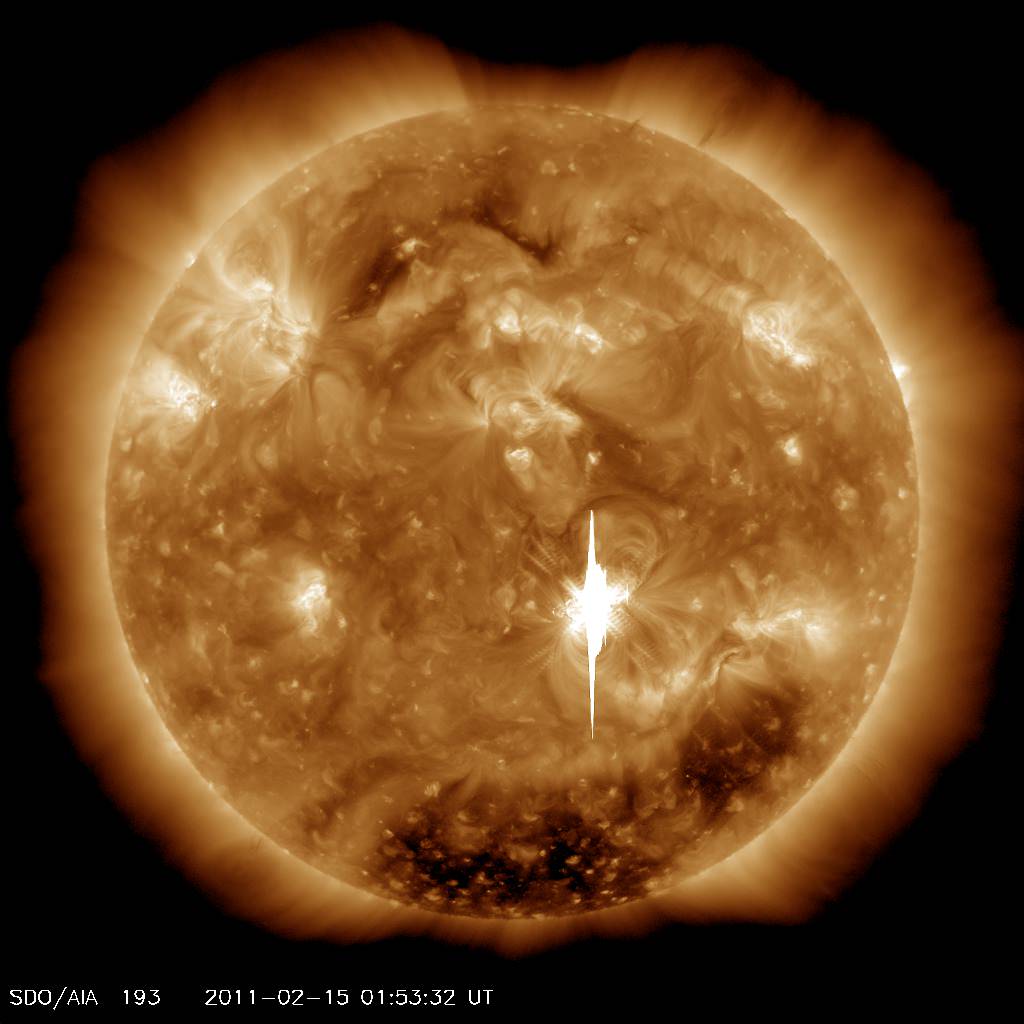
Just in time for Valentine’s Day, [and the Stardust flyby of Comet Tempel 1] the Sun erupted with a massive X-Class flare, the most powerful of all solar events on February 14 at 8:56 p.m. EST . This was the first X-Class flare in Solar Cycle 24 and the most powerful X-ray flare in more than four years.
The video above shows the flare as imaged by the AIA instrument at 304 Angstroms on NASA’s Solar Dynamics Observatory. More graphic videos below show the flare in the extreme ultraviolet wavelength of 193 Angstroms and as a composite with SOHO’s coronagraph.
Spaceweather Update: A CME hit Earth’s magnetic field at approximately 0100 UT on Feb. 18th (8:00 pm EST on Feb. 17th). Send me or comment your aurora photos
The eruption registered X2 on the Richter scale of solar flares and originated from Active Region 1138 in the sun’s southern hemisphere. The flare directly follows several M-class and C-class flares over the past few days which were less powerful. The explosion also let loose a coronal mass ejection (CME) headed for Earth’s orbit. It was speeding at about 900 Km/second.
CME’s can disrupt communications systems and the electrical power grid and cause long lasting radiation storms.
According to a new SDO update, the particle cloud from this solar storm is weaker than first expected and may produce some beautiful aurora in the high northern and southern latitudes on Feb. 17 (tonight).
According to spaceweather.com, skywatchers in the high latitudes should be alert for auroras after nightfall Feb. 17 from this moderately strong geomagnetic storm.
Send me your aurora reports and photos to post here
Sources: SDO website, spaceweather.com
NASA SDO – Big, Bright Flare February 15, 2011
Video Caption: Active region 1158 let loose with an X2.2 flare at 0153 UT or 8:50 pm ET on February 15, 2011, the largest flare since Dec. 2006 and the biggest flare so far in Solar Cycle 24. Active Region 1158 is in the southern hemisphere, which has been lagging the north in activity but now leads in big flares! The movie shows a close-up of the flaring region taken by the Solar Dynamics Observatory in the extreme ultraviolet wavelength of 193 Angstroms. Much of the vertical line in the image and the staggered lines making an “X” are caused by the bright flash overwhelming our imager. A coronal mass ejection was also associated with the flare. The movie shows activity over about two days (Feb. 13-15, 2011). Since the active region was facing Earth, there is a good chance that Earth will receive some effects from these events, with some possibility of mid-latitude aurora Feb. 16 – 18. Credit: NASA SDO
X2 flare Video combo from SDO and SOHO
Video caption: The X2 flare of Feb. 15, 2011 seen by SDO (in extreme ultraviolet light) enlarged and superimposed on SOHO’s coronagraph that shows the faint edge of a “halo” coronal mass ejection as it races away from the Sun. The video covers about 11 hours
[/caption]
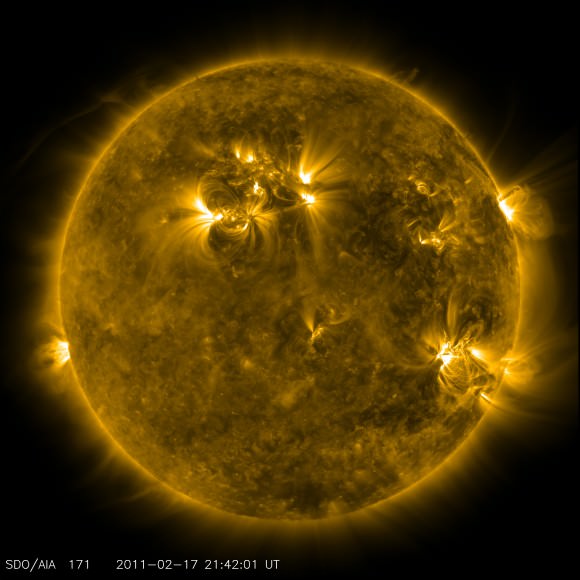
A Brief History of Observing the Sun
A little history of sun-watching and science from our friends at the Solar Dynamics Observatory.
First Ever Whole Sun View .. Coming Soon from STEREO
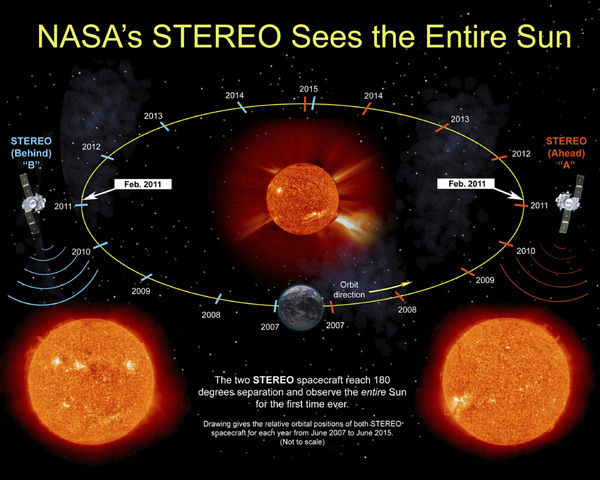
“For the first time in the history of humankind we will be able to see the front and the far side of the Sun … Simultaneously,” Madhulika Guhathakurta told Universe Today. Guhathakurta is the STEREO Program Scientist at NASA HQ.
Courtesy of NASA’s solar duo of STEREO spacecraft.
And the noteworthy event is timed to coincide just perfectly with ‘Super Bowl SUNday’ – Exactly one week from today on Feb. 6 during Super Bowl XLV !
“This will be the first time we can see the entire Sun at one time,” said Dean Pesnell, NASA Solar Astrophysicist in an interview for Universe Today. Pesnell is the Project Scientist for NASA’s Solar Dynamics Observatory at the NASA Goddard Spaceflight Center in Greenbelt, MD.
This remarkable milestone will be achieved when NASA’s two STEREO spacecraft reach position 180 degrees separate on opposite sides of the Sun on Sunday, Feb. 6, 2011 and can observe the entire 360 degrees of the Sun.
“We are going to celebrate by having a football game that night!” Pesnell added in jest.
The nearly identical STEREO spacecraft – dubbed STEREO Ahead and STEREO Behind – are orbiting the sun and providing a more complete picture of the Suns environment with each passing day. One probe follows Earth around the sun; the other one leads the Earth.
STEREO is the acronym for Solar TErrestrial RElations Observatory. Their mission is to provide the very first, 3-D “stereo” images of the sun to study the nature of coronal mass ejections.
Today, (Jan 30) the twin STEREO spacecraft are 179.1 degrees apart and about 90 degrees from Earth, and thus virtually at the midpoint to the back of the sun. See the orbital location graphics above and below.
Both probes were flung into space some four years ago and have been hurtling towards this history making date and location ever since. The wedge of unseen solar territory has been declining.
As the STEREO probes continue flying around to the back side of the sun, the wedge of unseen solar territory on the near side will be increasing and the SDO solar probe will play a vital gap filling role.
“SDO provides the front side view of the sun with exquisite details and very fast time resolution,” Gutharka told me. For the next 8 years, when combined with SDO data, the full solar sphere will still be visible.
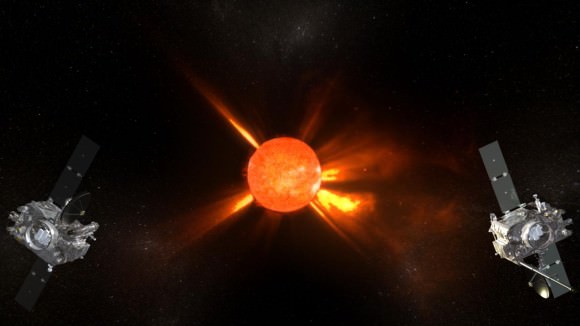
For the past 4 years, the two STEREO spacecraft have been moving away from the Earth and gaining a more complete picture of the sun. On February 9, 2011, NASA will hold a press conference to reveal the first ever images of the entire sun and discuss the importance of seeing all of our dynamic star.
Credit: NASA
The solar probes were launched together aboard a Delta II rocket from Launch Complex 17B at Cape Canaveral Air Force Station (CCAFS) in Florida on October 25, 2006. See Launch Video and Photos below.
Whole Solar Sphere A Goldmine for Science
I asked Pesnell and Guhathakurta to explain why this first ever whole Sun view is a significant scientific milestone.
“Until now there has always been an unseen part of the Sun,” Pesnell explained. “Although that unseen part has always rotated into view within a week or two, a global model must include all of the Sun to understand where the magnetic field goes through the surface.”
“Also, from the Earth we can see only one pole of the Sun at a time, while with STEREO we can see both poles at the same time.
“The next few years of overlapping coronal images will be a goldmine of information for predicting space weather at the Earth and understanding of how the Sun works. It is like getting the GOES images of the Earth for the first time. We haven’t missed a hurricane since, and now we won’t miss an active region on the Sun,” said Pesnell.
How will the science data collected be used to understand the sun and its magnetic field?
“Coronal loops trace out the magnetic field in the corona,” Pesnell elaborated. “Understanding how that magnetic field changes requires seeing where on the surface each loop starts and stops.”
Why is it important to image the entire Sun ?
“Once images of the entire Sun are available we can model the entire magnetic field of the Sun. This has become quite important as we are using STEREO and SDO to study how the entire magnetic field of the Sun reacts to the explosions of even small flares.”
“By seeing both poles we should be able to understand why the polar magnetic field is a good predictor of solar activity,” said Pesnell.
“Seeing both sides will help scientists make more accurate maps of global coronal magnetic field and topology as well as better forecasting of active regions – areas that produce solar storms – as they rotate on to the front side. Simultaneous observations with STEREO and SDO will help us study the sun as a complete whole and greatly help in studying the magnetic connectivity on the sun and sympathetic flares, ” Guhathakurta amplified.
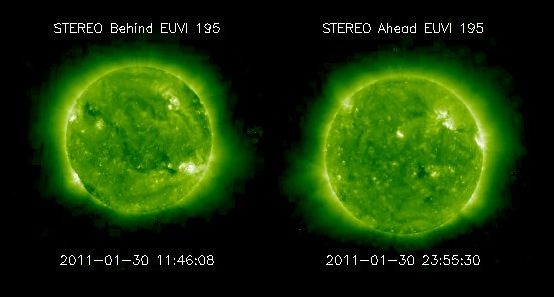
Watch a solar rotation animation here combining EUVI and SDO/AIA:
What is the role and contribution of NASA’s SDO mission and how will SDO observations be coordinated with STEREO?
“As the STEREO spacecraft drift around the Sun, SDO will fill in the gap on the near of the Sun,” explained Pesnell. “For the next 4 or more years we will watch the increase in sunspots we call Solar Cycle 24 from all sides of the Sun. SDO has made sure we are not doing calibration maneuvers for a few days around February 6.”
“On Feb 6th we will view 100% of the sun,” said Guhathakurta.
At a press conference on Feb. 9, 2011, NASA scientists will reveal something that no one has even seen – The first ever images of ‘The Entire Sun’. All 360 degrees
Watch the briefing on NASA TV at 2 PM EST
More about the SDO mission and SDO science
and Coronal holes from STEREO and SDO here
“3D Sun”
A STEREO Movie in Digital and IMAX was released in 2007
Watch the way cool 3D IMAX trailer below
STEREO spacecraft location map
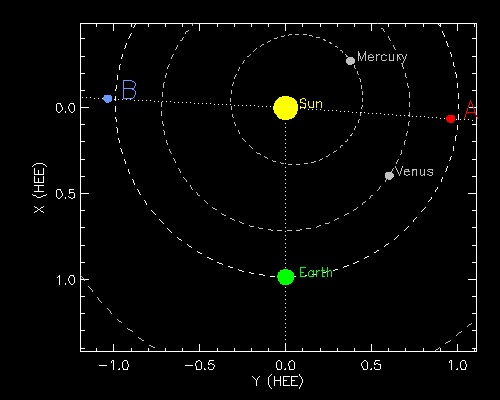
Caption: Positions of STEREO A and B for 31-Jan-2011 05:00 UT. The STEREO spacecraft are 179.2 degrees apart and about 90 degrees from Earth on Jan. 31, 2011. This figure plots the current positions of the STEREO Ahead (red) and Behind (blue) spacecraft relative to the Sun (yellow) and Earth (green). The dotted lines show the angular displacement from the Sun. Units are in A.U. (Astronomical Units). Credit: NASA
STEREO Launch Video
Launch Video Caption: The Delta II rocket lights the evening sky as STEREO heads into space on October 25, 2006 at 8:52 p.m. The Delta II rocket lights the evening sky as STEREO heads into space. STEREO (Solar Terrestrial Relations Observatory) is a multi-year mission using two nearly identical observatories, one ahead of Earth in its orbit and the other trailing behind. The duo will provide 3-D measurements of the sun and its flow of energy, enabling scientists to study the nature of coronal mass ejections and why they happen.
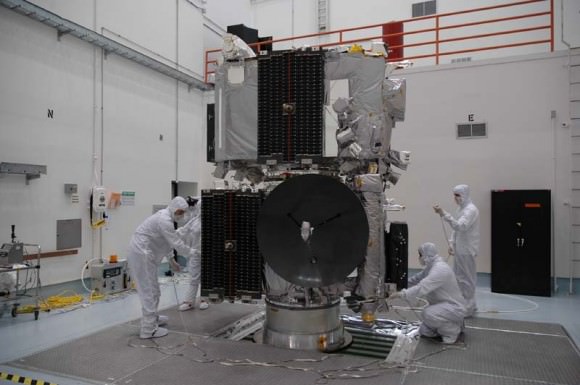
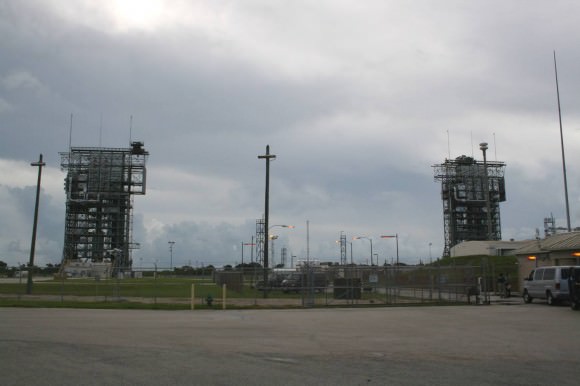
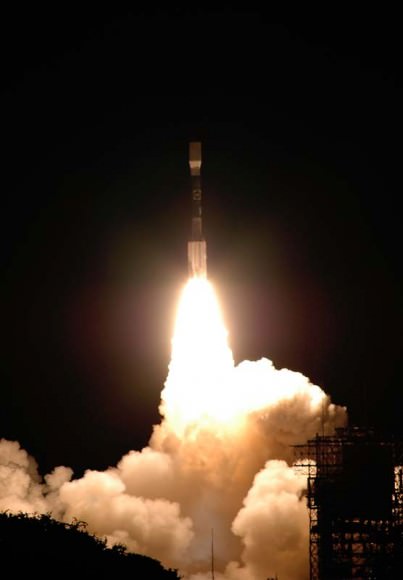
More STEREO Cleanroom and Launch photos from nasatech.net here
More about the SDO mission and SDO science
and Coronal holes from STEREO and SDO here
“3D Sun”
A STEREO Movie in Digital and IMAX was released in 2007
Watch the way cool 3D trailer here – Trailer narrated by NASA’s Madhulika Guhathakurta
— be sure to grab hold of your Red-Cyan Glasses
Double Explosions on the Sun Today
The Sun had a fit and popped off two large events at once early today, Jan. 28, 2011. A filament on the left side became unstable and erupted, while an M-1 flare (mid-sized) and a coronal mass ejection on the right blasted into space. Neither event was headed towards Earth. This SDO movie, which is from Jan. 26-28, 2011, shows several other flashes and bursting from the active region on the right as well.
If you remember, in December, solar physicists released their findings that near-synchronous explosions in the solar atmosphere – sometimes millions of kilometers apart – can be related.
You can see another view of the events as seen by the SOHO spacecraft below, and another version of the SDO data.
Continue reading “Double Explosions on the Sun Today”
